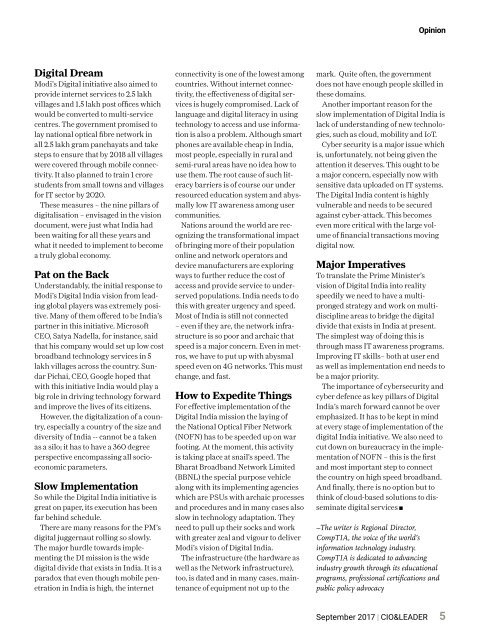CIO & LEADER-Issue-06-September_iPad
The cover story of CIO&Leader issue of September tackles the issue of workforce reskilling in the advent of disruptive technologies such as Artificial Intelligence, IoT, among others.
The cover story of CIO&Leader issue of September tackles the issue of workforce reskilling in the advent of disruptive technologies such as Artificial Intelligence, IoT, among others.
You also want an ePaper? Increase the reach of your titles
YUMPU automatically turns print PDFs into web optimized ePapers that Google loves.
Opinion<br />
Digital Dream<br />
Modi’s Digital initiative also aimed to<br />
provide internet services to 2.5 lakh<br />
villages and 1.5 lakh post offices which<br />
would be converted to multi-service<br />
centres. The government promised to<br />
lay national optical fibre network in<br />
all 2.5 lakh gram panchayats and take<br />
steps to ensure that by 2018 all villages<br />
were covered through mobile connectivity.<br />
It also planned to train 1 crore<br />
students from small towns and villages<br />
for IT sector by 2020.<br />
These measures – the nine pillars of<br />
digitalisation – envisaged in the vision<br />
document, were just what India had<br />
been waiting for all these years and<br />
what it needed to implement to become<br />
a truly global economy.<br />
Pat on the Back<br />
Understandably, the initial response to<br />
Modi’s Digital India vision from leading<br />
global players was extremely positive.<br />
Many of them offered to be India’s<br />
partner in this initiative. Microsoft<br />
CEO, Satya Nadella, for instance, said<br />
that his company would set up low cost<br />
broadband technology services in 5<br />
lakh villages across the country. Sundar<br />
Pichai, CEO, Google hoped that<br />
with this initiative India would play a<br />
big role in driving technology forward<br />
and improve the lives of its citizens.<br />
However, the digitalization of a country,<br />
especially a country of the size and<br />
diversity of India -- cannot be a taken<br />
as a silo; it has to have a 360 degree<br />
perspective encompassing all socioeconomic<br />
parameters.<br />
Slow Implementation<br />
So while the Digital India initiative is<br />
great on paper, its execution has been<br />
far behind schedule.<br />
There are many reasons for the PM’s<br />
digital juggernaut rolling so slowly.<br />
The major hurdle towards implementing<br />
the DI mission is the wide<br />
digital divide that exists in India. It is a<br />
paradox that even though mobile penetration<br />
in India is high, the internet<br />
connectivity is one of the lowest among<br />
countries. Without internet connectivity,<br />
the effectiveness of digital services<br />
is hugely compromised. Lack of<br />
language and digital literacy in using<br />
technology to access and use information<br />
is also a problem. Although smart<br />
phones are available cheap in India,<br />
most people, especially in rural and<br />
semi-rural areas have no idea how to<br />
use them. The root cause of such literacy<br />
barriers is of course our under<br />
resourced education system and abysmally<br />
low IT awareness among user<br />
communities.<br />
Nations around the world are recognizing<br />
the transformational impact<br />
of bringing more of their population<br />
online and network operators and<br />
device manufacturers are exploring<br />
ways to further reduce the cost of<br />
access and provide service to underserved<br />
populations. India needs to do<br />
this with greater urgency and speed.<br />
Most of India is still not connected<br />
– even if they are, the network infrastructure<br />
is so poor and archaic that<br />
speed is a major concern. Even in metros,<br />
we have to put up with abysmal<br />
speed even on 4G networks. This must<br />
change, and fast.<br />
How to Expedite Things<br />
For effective implementation of the<br />
Digital India mission the laying of<br />
the National Optical Fiber Network<br />
(NOFN) has to be speeded up on war<br />
footing. At the moment, this activity<br />
is taking place at snail’s speed. The<br />
Bharat Broadband Network Limited<br />
(BBNL) the special purpose vehicle<br />
along with its implementing agencies<br />
which are PSUs with archaic processes<br />
and procedures and in many cases also<br />
slow in technology adaptation. They<br />
need to pull up their socks and work<br />
with greater zeal and vigour to deliver<br />
Modi’s vision of Digital India.<br />
The infrastructure (the hardware as<br />
well as the Network infrastructure),<br />
too, is dated and in many cases, maintenance<br />
of equipment not up to the<br />
mark. Quite often, the government<br />
does not have enough people skilled in<br />
these domains.<br />
Another important reason for the<br />
slow implementation of Digital India is<br />
lack of understanding of new technologies,<br />
such as cloud, mobility and IoT.<br />
Cyber security is a major issue which<br />
is, unfortunately, not being given the<br />
attention it deserves. This ought to be<br />
a major concern, especially now with<br />
sensitive data uploaded on IT systems.<br />
The Digital India content is highly<br />
vulnerable and needs to be secured<br />
against cyber-attack. This becomes<br />
even more critical with the large volume<br />
of financial transactions moving<br />
digital now.<br />
Major Imperatives<br />
To translate the Prime Minister’s<br />
vision of Digital India into reality<br />
speedily we need to have a multipronged<br />
strategy and work on multidiscipline<br />
areas to bridge the digital<br />
divide that exists in India at present.<br />
The simplest way of doing this is<br />
through mass IT awareness programs.<br />
Improving IT skills– both at user end<br />
as well as implementation end needs to<br />
be a major priority.<br />
The importance of cybersecurity and<br />
cyber defence as key pillars of Digital<br />
India’s march forward cannot be over<br />
emphasized. It has to be kept in mind<br />
at every stage of implementation of the<br />
digital India initiative. We also need to<br />
cut down on bureaucracy in the implementation<br />
of NOFN – this is the first<br />
and most important step to connect<br />
the country on high speed broadband.<br />
And finally, there is no option but to<br />
think of cloud-based solutions to disseminate<br />
digital services<br />
–The writer is Regional Director,<br />
CompTIA, the voice of the world’s<br />
information technology industry.<br />
CompTIA is dedicated to advancing<br />
industry growth through its educational<br />
programs, professional certifications and<br />
public policy advocacy<br />
<strong>September</strong> 2017 | <strong>CIO</strong>&<strong>LEADER</strong><br />
5














